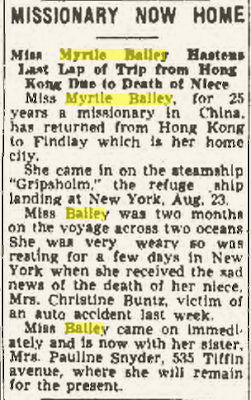 |
| ”Missionary Returning” 18 August 1942, The Findlay Republican Courier, p. 13. Click to Make Bigger |
Transcription:
 |
| ”Missionary Now Home” 14 September 1942, The Findlay Republican Courier p. 12 Click to Make Bigger |
Transcription:
Miss Bailey came on immediately and is now with her sister, Mrs. Pauline Snyder, 535 Tiffin Avenue, where she will remain for the present.
 |
"Missionary will tell of Hong Kong”,
19 September 1942, Findlay Republican Courier, p 13.
Click to Make Bigger
|
 |
| ”Missionary tells of Bombings” 21 September 1942, The Findlay Republican Courier, p. 3 Click to Make Bigger |
Transcription:
Myrtle Bailey Relates Experiences in Attack on Hong Kong
“Hong Kong thought it was prepared, but it was caught off guard, “ Miss Myrtle bailey told the Assembly of God, 406 E. Sandusky Street, Sunday Evening.
“The Japanese crept in from the back, camouflaged by weeds and grass. They were in front of Hong Kong before the British saw them move, “ Miss Bailey said. On the ferry on British soldier told her that the Japs outnumbered the Allies in Hong Kong 20 to 1.
“The attack was sudden,” the speaker continued. “First the bombers set fire to the aerodromes then they stormed the warehouses where a two year food supply was stored. The Allies could do nothing but retreat to Hong Kong Island, “ she said.
Most of the damage was done in the tenement districts. Most of the government buildings and banks were saved, she explained.
Miss Bailey said she lived on the mainland at the very edge of Hong Kong’s foreign settlement, next to the Chinese section. The Japanese took the house opposite her for Red Cross headquarters. Three others near her were taken for barracks. One Jap officer lived on the second floor of her home. “They just took what they wanted, “ Miss Bailey said.
The speaker said she was never interned in a camp but was virtually a prisoner in her own home for seven and a half months. She had almost given up hope when word came that she could leave.
When in China Miss Bailey established two missions, two schools, a boys’ and a girls’, opened a Bible school, and kept 15 orphans in her home.
A Red Cross shipment of food stuff was used to aid Hong Kong. Miss Bailey said she had eight large bags in her home when the bombings came. Fifty people were in her home during the bombings.
“I know what starvation is,” Miss Bailey said. “The older girls knitted for the Japs to get food, and the younger girls sold candy and cakes on the streets. We sold our furniture – everything, even to the typewriter.”
Finally word came through a Red Cross representative that she could leave but could only take four suitcases with her. She was on the Japanese Ship Asama Maru until she reached Lourenco Marques. There Gripsholm picked up the refugees and brought them to New York. There were 500 to 700 missionaries on the ship, she said.
 |
”Missionary Will Speak to W. M. S.” 29 September 1942, Findlay Republican Courier, p 5. Click to Make Bigger |
 |
| ”Leaving for China” 20 September 1947, Findlay Republican Courier, p 9 Click to Make Bigger |
- First in series: Myrtle Bailey and the Second Chinese revolution
- Second in series: Myrtle Bailey and the Second Sino-Japanese War

Myrtle lived an amazing life, Jo. She was one adventurous and courageous woman.
ReplyDeleteThank you! I wish I'd known her in life. I was 1o when she died, but never met her. She is an inspiration to me now.
DeleteI've been interested in Myrtle's story since you started writing about her, and I still find her fascinating!
ReplyDeleteI have just discovered a great aunt who was a missionary in Assam and I'm sure her life was interesting. I just wrote a post about her (Esther Stanard Dring), but I have far fewer details about Esther than you have about Myrtle. I hope to learn more as I have more time to research, but isn't it amazing what the women in our families did?
It really is. Myrtle is an inspiration to me now.
DeleteI hope you find out lots about your aunt, too. Now I'm off to read your post about Esther!